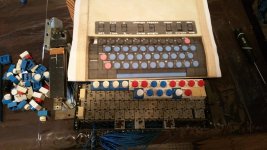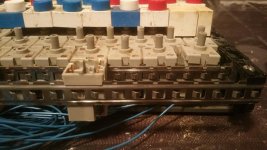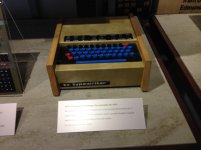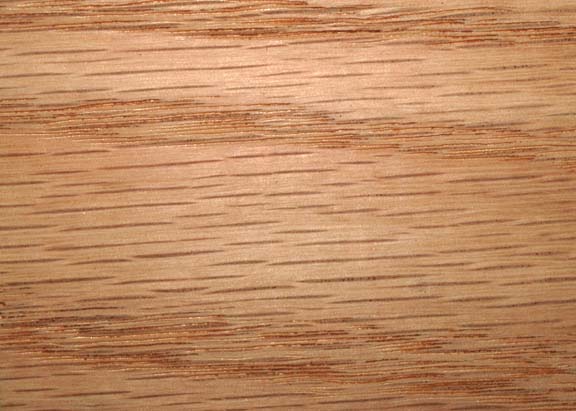Okay so this weekend I'm going to work a bit on the keyboard situation, mainly to aid in finishing the case. As the case sits right now, the keyboard just barely squeezes into it. These MDS keyboards are almost like Lego -- the keys are square, and to fill in spots where there are no keys there are either 'blank' squares or half squares. Looking at Don's and mine (mine with the keytops mostly removed):

My keyboard has approximately 12 keys per row. Don's has 11. Don apparently completely disassembled these keyboards, re-arranging them based on the colour of keytop he wanted. It appears the final pattern he has is very close to mine -- the space bar appears to be a half space to the left (or all the keys a half space to the right), the 12 keys removed and replaced by blanks, and a full row of blanks added on the left side. Based on what I can calculate, it works out to about the same width, maybe a half block wider. Now, as we can see with mine, the keys screw into these twin rails which are then slide locked into one another:

Kind of cool -- I can sort of picture the Mohawk people assembling these according to each individual client's needs. The blanks I can replicate easily. I can even replicate the keytops, and will to have spares around or if some future TVT replicator wants them and can't find an original MDS keyboard.
What's unclear from photos of the prototype is how Don integrated the twin rails the keys lock into into the design. In
this photo we can see a hint of a metal bracket appearing there. There's more of it exposed in this later photo:

It's not anything from inside the MDS keyboard I have. Some kind of custom bracket he used. I'm guessing left the outer lip of the MDS keyboard 'rails' sits just under it, and the right outer lip is recessed into the side of his case.
The other thing I'm confronted with is the wiring. As you can see, the keys are 'tied' to one another (black wires):

My understanding is, based on both Don's words, these keyboards were wired for EBCDIC encoding, and needed to be completely rewired. Don mentions this in the second of these two articles on building encoders, the first an early version appearing before the TVT article:
http://www.tinaja.com/glib/rad_elec/ascii_encoder_4_73.pdf
And then an 'improved' one after:
http://www.tinaja.com/glib/impascii1.pdf
The first encoder article mentions the original 'low cost keyboard' Don devised in a previous article. He calls these simple "make" contact switches. I'm guessing that means the switches just completed a simple circuit when pressed, and presumably on the circuit board they took care of how the keys tied to one another, if at all.
Check out the picture on page 3 of the second encoder article. A keyboard just like the TVT's, keys configured exactly the same way. The metal brackets on the side look similar to what was exposed in the second photo, and I *think* he reused the rails the keys sit in, although that pic is poor quality. On the second last page, he specifically mentions these 'keypunch' keyboards, and details a bit of what I suspect he did in rearranging the keys and surrounds (what I think he is calling 'callouts'). However on this particular one the encoder is mounted to the right, and that wouldn't fit in the original TVT case. So I'm guessing he did as he said -- they took about 60 of these 'surplus' keypunch keyboards and rebuilt 40 of them to that standard, and in the original TVT he wired up whichever encoder he used and tucked it under the keyboard.
So I guess my questions are: which encoder should I use? The older encoder is supposedly more complex, but it has ICs I can get my hands on. The second encoder I cannot find one IC at all, and the other I can't find that matches, exactly, the model he's calling for.
I'm also trying to understand the whole keyboard matrix business. Based on what Don is saying, I need to completely desolder my keyboard switch wires, and then rewire according to the matrix he has in the schematics? So if I did that, say I was soldering wires for key 'A' in the first encoder design, the 'A' key would have a wire to the encoder lead, and then also connect to P-W? Sorry.. I suck at this.. maybe somebody can explain it better to me. I sort of get the concept but not the execution.
And one more question. Back when Don was doing this, these MDS keyboards were plentiful and not special. However in 2015, they're quite rare, and although the machine they attach to, the important part, is long gone, the keyboard seems like a nice piece in its own right. Should I be reluctant to hack this thing up, repaint keys, etc? I don't care about desoldering wires since I'll never have an actual MDS key to tape machine to reconnect this thing to. But I do have a bit of queasiness about removing keys entirely and painting over the original callouts. Am I being silly?






